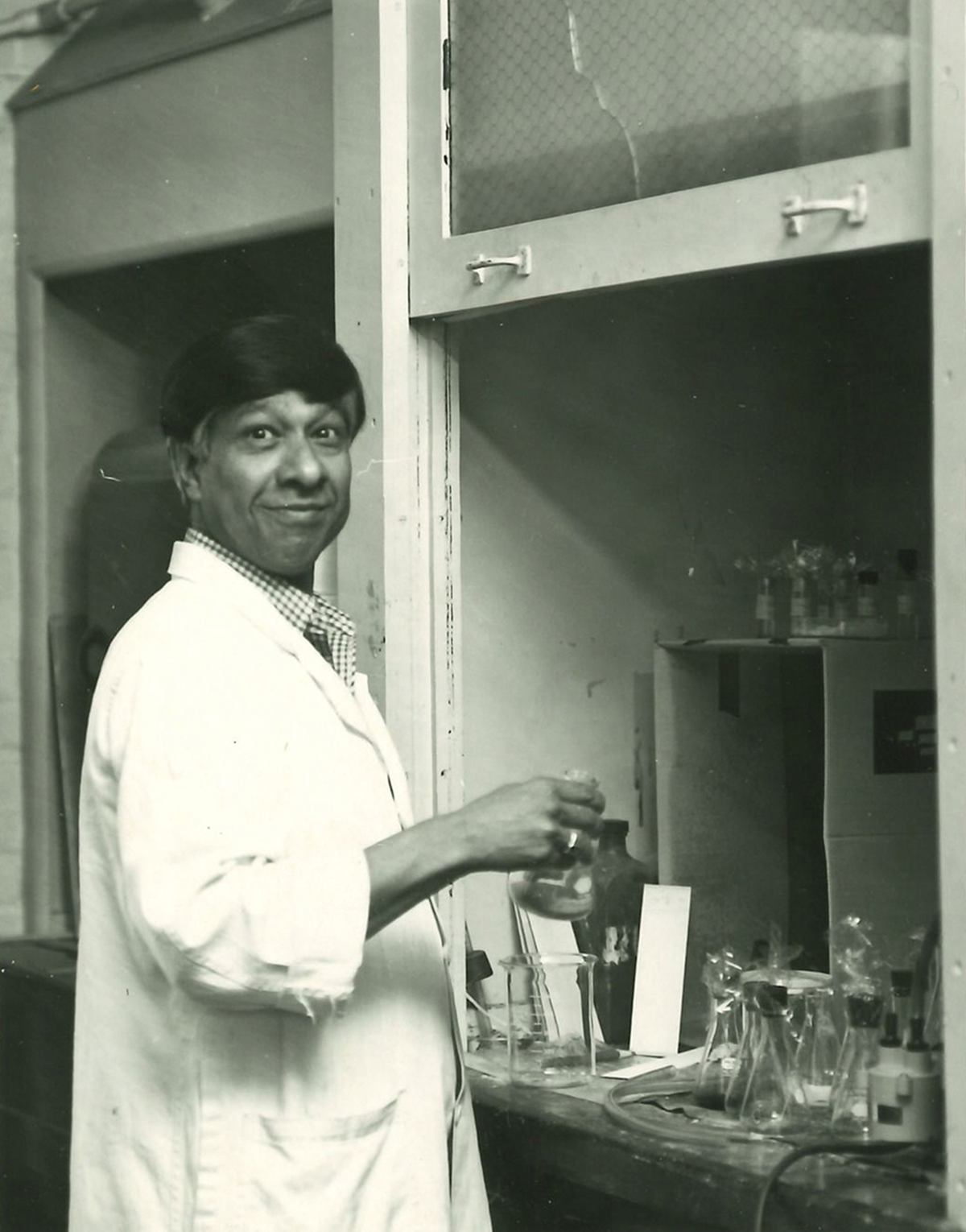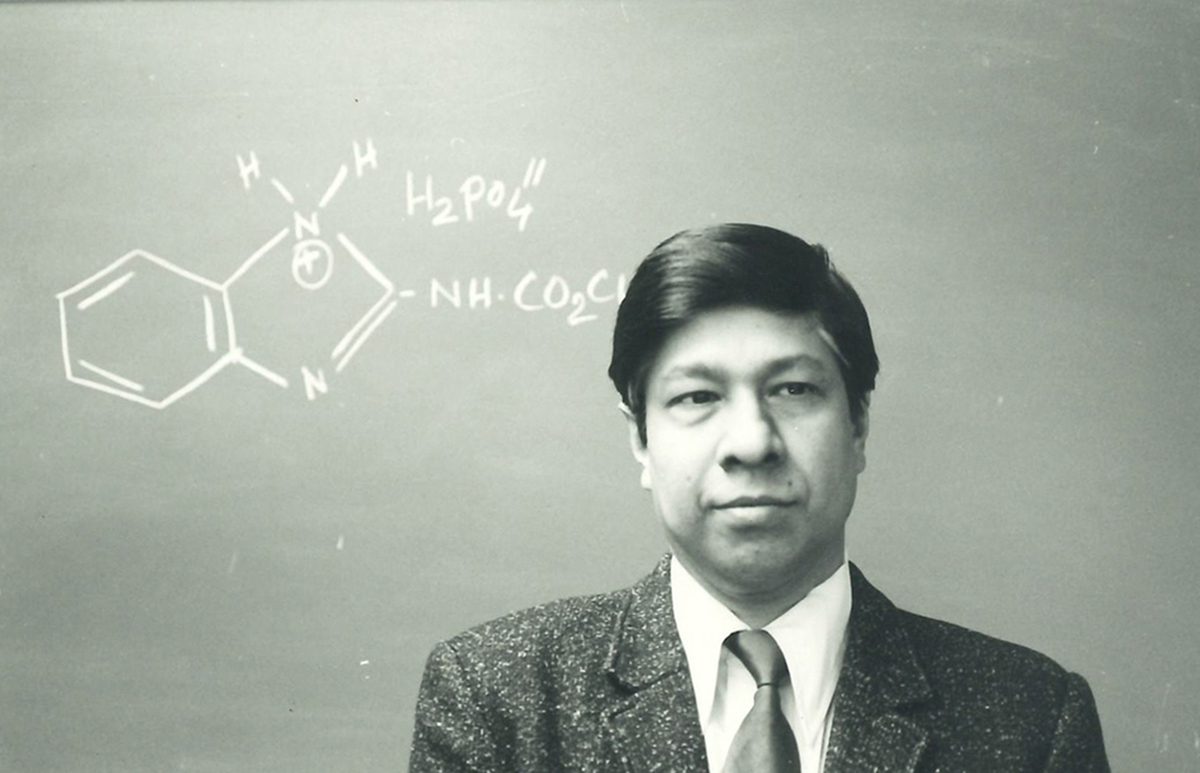
22.03.21 - D.N. Roy, forestry professor who developed the first treatment for Dutch elm disease, dies at 85
D.N. Roy, a chemist and professor of forestry who developed the first effective treatment for a fast-spreading disease that killed elm trees around the world throughout the 20th century, died on February 16, of complications related to Alzheimer's disease. He was 85 years old.
Roy joined the University of Toronto's Faculty of Forestry in 1968. As part of the Shade Tree Research Laboratory, a forest pathology laboratory led by Eric Jorgensen, Roy began investigating possible chemical treatments for elm trees, which for decades had been dying by the millions as a result of the global spread of Dutch elm disease, a fungal infection carried by bark beetles.
The chemical solution Roy developed, eventually marketed by DuPont under the trade name Lignasan BLP, was effective at preventing — and, to some extent, reversing — the effects of Dutch elm disease. It offered the first glimmer of hope in a multi-decade fight to save elm trees, which at the time were a dominant species of shade tree in urban areas. The discovery won Roy international acclaim and established him as an estimable figure at the Faculty of Forestry, where he continued working until his retirement in 2001.
His path to the University of Toronto was a long one. Dibyendu Roy (he adopted the nickname D.N. to help North American colleagues with pronunciation) was born on December 29, 1935 in the East Bengal city of Mymensingh, in what was then eastern India. In 1947, when the Partition of Bengal made the city a part of Pakistan, Roy, his parents, and his three siblings relocated to Kolkata.
Roy had been interested in Bengali music from an early age, but his father, a district judge, insisted that his sons enter the professions. Roy decided to study chemistry at Presidency College, University of Kolkata, where he earned his PhD in organic chemistry.
In 1965, Roy received a Fulbright award that enabled him to start a postdoctoral fellowship at the University of Connecticut. It was there that he met his future wife, Marie, a first-year graduate student in chemistry.
In 1968, Roy was doing a final year of postdoctoral work at Rensselaer Polytechnic Institute. Reluctant to bring Marie back to India, he was looking for ways to remain in North America. The terms of his Fulbright award required him to settle in a Commonwealth country.
Around this time, he noticed an ad in Nature magazine from the Shade Tree Research Lab at the University of Toronto. The lab was looking for a chemist to support its work on urban forestry and Dutch elm disease. Roy landed the job and moved to Canada. The following year, he and Marie were married and she joined him in Toronto.

At the time, U of T's forestry researchers were struggling to deal with local fallout from the spread of Dutch elm disease. In the summer of 1968 alone, the university was forced to remove 32 diseased elms from its own campus, including a number of important shade trees near the university's main south entrance, on King's College Road.
Roy's breakthrough came when he began experimenting with a chemical called benomyl, which had been developed by DuPont. Benomyl had been found to be effective at eliminating the fungus responsible for Dutch elm disease, but there was no good way of getting it inside a tree, because it wasn't water soluble. Researchers had tried applying it directly to the soil around the roots of elm trees, but the trees couldn't absorb enough of the chemical to make a significant difference in their ability to fight off the disease.
Roy and his colleagues at the Shade Tree Research Laboratory reviewed the literature and discovered a previous study that suggested something interesting: benomyl itself was not the chemical responsible for killing the Dutch elm fungus. The fungicidal effects of benomyl were actually a result of the fact that benomyl molecules were unstable and had a tendency to break down into another chemical, methyl-2-benzimidazole carbamate, or MBC. It was MBC, not benomyl, that was responsible for inhibiting the disease.
By manipulating the MBC molecule, Roy was able to increase the substance's water solubility. In 1973, he co-authored a paper for the Canadian Journal of Forest Research that described the effects of putting a solution of one of these modified molecules, MBC-phosphate, directly into the roots of trees, using an injection method developed by Edward Kondo, a PhD student. Testing by Roy and his colleagues found that MBC-phosphate was detectable in the upper crowns of trees in as little as 30 minutes after an injection. The experiment was a success.

The high cost of the treatment (about $200 to $300 per tree, in 1974 dollars), limited its utility. Nevertheless, Lignasan BLP was used widely to protect treasured shade trees in populated areas. Roy was lauded in the press as a tree saviour.
The University of Toronto patented the technique and split the royalties from sales of the treatment with the Canadian federal government. Roy and his colleagues each received a symbolic $5 payment for their work. "This is the way it should be, since the university sponsored our lengthy research as an example of its concern for the welfare of the general community, in this case the owners of elm trees," Roy told the University of Toronto Bulletin in 1975.
In a 1979 CBC interview, Roy was asked why he was able to develop a treatment for Dutch elm disease when many others in the forestry field had tried and failed. "In all cases they lacked the input from a biochemist," he said. "It has always been the domain of the foresters. They thought they could solve it. They just couldn't do it — the final thing."
In the 1980s, Roy shifted his research focus from shade trees to herbicides. He performed pioneering research on glysophate, the active ingredient in Roundup-brand weed killer. In a 1989 article published in the Canadian Journal of Forest Research, Roy presented evidence that the chemical remained present in the fruit of wild blueberry and raspberry plants weeks after application.
In the final decades of his career, Roy's main research focus was finding alternatives to wood pulp. He experimented with ways of processing and treating fibrous plants, like hemp and kenaf, in order to discover methods of manufacturing pulp and paper products without putting additional strain on the world's dwindling forest resources.
Throughout his career, Roy was known at the Faculty of Forestry as a kind and reliable coworker and mentor. Samir Konar first met him in 1979, when Roy was giving a seminar in India. Roy helped Konar apply for a Canadian visa and then took him on as a postdoctoral fellow. The two worked together on Roy's herbicide research throughout the 1980s. "The students and the researchers all liked him. He had a unique personality, always jolly," Konar says. "He was not only my mentor but almost like my elder brother."
Roy taught chemistry at the Faculty of Forestry. He was known for making the subject — ordinarily a difficult one for ecology-minded students — accessible and comprehensible. "Teaching chemistry to forestry students is not an easy task, so you would think he'd be one of the more unliked professors," says Sally Krigstin, who studied under Roy as a graduate student in the early 1980s and is now an assistant professor of forestry at the Daniels Faculty. "But that was not how it worked. He managed to teach them."
And studying under Roy had other benefits. "He was very good at keeping connections with all his students and helping his current students through his connections," Krigstin says. "And everybody was thrilled to help because of how much Dr. Roy gave to them."
During his years in Canada, Roy stayed connected to the Bengali community. He worked to help students of Bengali origin find pathways into the sciences. And he never lost his childhood passion for Bengali music. In his spare time, he enjoyed listening to his collection of Bengali tapes and LPs. He was an aficionado of audio technology, and would often use his equipment to record performances by Bengali musicians who visited the Toronto area.
Roy is survived by his wife, Marie; their two children, Ravi and Dia; three grandchildren, Reishaan, Jaiden, and Mirella; and his sisters, Tapati and Bharati.

